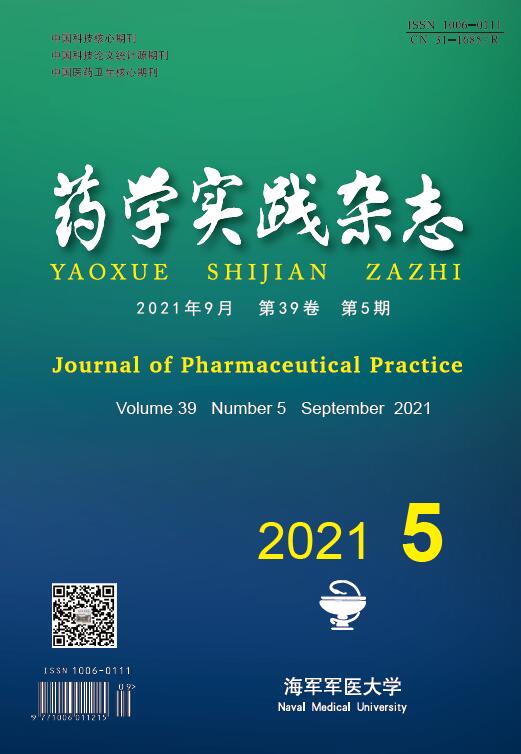-
氯吡格雷是一种前药,其代谢产物是血小板聚集抑制剂,可以选择性地抑制二磷酸腺苷(ADP)与其血小板P2Y12受体的结合及继发的ADP介导的糖蛋白GPⅡb/Ⅲa复合物的活化。它是经皮冠状动脉介入治疗(PCI)术后治疗方案中的主要药物,可以改善疾病的预后,预防支架内再狭窄[1]。但氯吡格雷作为前药,需要经肝药酶代谢为活性产物才能发挥药效。此外,还有其他因素会影响氯吡格雷的血药浓度和临床疗效,包括基因多态性,生理状况,肝肾功能、合用药物以及年龄等[2]。研究表明,主要是编码CYP2C19酶的等位基因突变会导致氯吡格雷代谢减慢,使其对血小板的抑制作用减弱。已有报道认为在亚裔人群中,能导致P450酶活性下降或者丢失的等位基因有两个位点,一个是CYP2C19*2,另一个是CYP2C19*3,这两个等位基因的突变都会导致氯吡格雷疗效减弱[3-5]。
由于氯吡格雷的疗效和不良反应存在个体差异,不同患者的剂量需求不一样[6-7]。本研究通过实验对PCI术后患者的代谢酶基因型和体内血药浓度进行测定,探索基因多态性对血药浓度、血小板抑制率和安全性的影响,来指导临床实施个体化治疗,为PCI术后患者的合理治疗提供依据。
HTML
-
LC-20AB高效液相色谱系统(检测器为SPD-M20A,日本岛津);TG1650-WS高速离心机(上海卢湘仪);乙腈(色谱纯,德国Merck);甲酸(分析纯,中国国药集团)。荧光检测仪(西安天龙科技有限公司);PHARM-GENE 01 SNP分析保存液;PHARM-GENE 200 SNP分析样本处理试剂;NH4Cl预处理液。氯吡格雷片(波立维,75mg,赛诺菲制药,批准文号:J20180029),阿司匹林肠溶片(拜阿司匹林,100mg,批准文号:H20130339)。
-
纳入2017年6月至2019年12月心内科87 例PCI 术后服用氯吡格雷联合阿司匹林抗血小板治疗的患者(氯吡格雷75mg,1次/d;阿司匹林100 mg,1次/d)。
纳入标准如下:①接受氯吡格雷联合阿司匹林双抗治疗的患者,年龄<80岁;②氯吡格雷用药时间应大于5 d,以保证体内药物处于稳态。
排除标准如下:①使用了对药物代谢酶活性有影响的药物,包括细胞色素P450 的诱导剂(如苯巴比妥、水合氯醛、苯妥英钠、利福平等)和活性抑制剂(如氯霉素、对氨基水杨酸、异烟肼、保泰松等);②治疗前或治疗中发生了肝或肾功能改变;③同一份样品,经多次测量,其血药浓度变异系数(CV)>25%。本研究经医院伦理委员会批准(批号:2017-KL002-03)。
-
药物在体内经4~5个给药周期可以达到稳态,所以于氯吡格雷开始服药后第6天,在给药前静脉采血。
-
使用RP-HPLC法检测人血浆中氯吡格雷的药物浓度,血清样品300 μl置于1.5 ml离心管中,加内标溶液900 μl,涡旋振荡30 s,以15000 r/min转速,离心3 min,取上清液10 μl,经0.45 μm滤膜过滤后进样分析[8]。
-
使用非扩增免疫杂交技术检测CYP2C19的基因型,操作步骤:①使用耀金保预处理标本,收集DNA;②耀金分带有针对特定SNP位点的荧光染色原位杂交探针,使用耀金分对标本DNA进行原位杂交检测;③标本DNA中含有特定碱基时可以检测到荧光信号,判断目标碱基类型[9]。
-
血栓弹力图是一种检测方式,便于快速、准确地对血小板的活性以及抗血小板聚集的效果进行评价和分析。记录的参数包括:凝血反应时间(R)、凝血形成时间(K)、凝固角(α)、最大血凝块强度(MA)和综合凝血指数。
-
氯吡格雷最主要的不良反应包括呼吸困难以及出血。根据国际多中心、随机对照试验(PLATO)[10],按照呼吸困难的程度划分:轻度,易于察觉到的轻微呼吸困难症状,但可以耐受,不影响正常体力活动;中度,呼吸困难影响了正常的体力活动,但可以耐受;重度,呼吸困难导致无法完成正常的体力活动。根据PLATO研究[10]将出血事件分为:主要出血和次要出血。
-
样本的基因频率经Hardy-Weinberg遗传平衡检验,检验结果P>0.05,表明收集的样本符合H-W平衡,具有群体代表性。所有数据采用SPSS20.0进行统计分析。率的比较选择双侧χ2检验,各组之间的血药浓度比较采用方差分析或t检验,P<0.05为差异有统计学意义。
1.1. 仪器与试剂
1.2. 研究对象
1.3. 血样采集与检测
1.3.1. 血样采集
1.3.2. 氯吡格雷血药浓度监测
1.3.3. CYP2C19基因型的检测
1.4. 血小板抑制率的评估
1.5. 安全性评估
1.6. 统计分析
-
本研究中共纳入87名患者,均检测了CYP2C19的基因型和氯吡格雷的血药浓度测定。其中男性46名,女性41名,患者平均年龄为(66.2±7.9)岁,平均体重(55.3±12.3)kg。患者基本情况及检测结果见表1。对样本CYP2C19的基因频率进行了Hardy-Weinberg遗传平衡检验,计算结果Chi-square为1.12,P>0.5,结果见表2。结果表明,收集的样本符合H-W平衡,具有群体代表性。
项目 信息 值 人口学特征 性别(男/女) 46/41 年龄(n±s) 66.2±7.9 体重(n±s) 55.3±12.3 基因型 快(例) 34 中(例) 38 慢(例) 15 血栓弹力图参数 R(min) 5.72±1.51 K(min) 1.52±0.33 α角(deg) 70.44±7.02 MA(mm) 65.58±5.93 综合凝血指数 1.01±1.33 血小板抑制率(%) 62.56±31.22 不良反应 呼吸抑制(%) 10.34%(9/87) 出血(%) 5.75%(5/87) 基因表型 基因型 基因频率/% Chi-square H-W平衡检验/P 快 CYP2C19*1/*1 43.59(34/87) 1.12 >0.5 中 CYP2C19*1/*2 48.71(38/87) CYP2C19*1/*3 慢 CYP2C19*2/*2 7.69(15/87) CYP2C19*3/*3 -
87例患者接受氯吡格雷治疗后,血药浓度分布于2~7 mg/L之间,血小板抑制率分布于20%~90%之间。常见的不良反应是呼吸抑制[10.34%(9/87)]和出血[5.75%(5/87)]。
-
在本研究中,根据CYP2C19的基因型进行了分类(快、中、慢)。快、中和慢代谢型患者的平均血药浓度分别为2.64±1.03、2.88±1.79和5.23±3.23 mg/L,使用t检验分析两两之间的血药浓度,结果显示,血药浓度在快、中代谢型之间没有显著性差异(P=0.667),但慢代谢型中的血药浓度在与快、中代谢型比较时有统计学差异(P<0.05)。快、中、慢代谢型的血小板抑制率分别是(66.26±24.71)%、(67.77±22.32)%和(42.45±17.88)%,采用方差分析进行统计,显示基因多态性对血小板抑制率有显著性影响(P<0.05)。不良反应发生率分别是8.97%(7/87)、5.13%(4/87)和0%(0/87),采用Fishier确切概率法对不良反应进行统计分析,结果显示,基因多态性对用药安全亦有显著性影响(P<0.05),见表3。
基因型 基因多态性 浓度(mg/L) 血小板抑制率(%) 不良反应(%) 快 CYP2C19*1/*1 2.64±1.03 66.26±24.71 8.97(7/87) 中 CYP2C19*1/*2 2.88±1.79 67.77±22.32 5.13(4/87) CYP2C19*1/*3 慢 CYP2C19*2/*2 5.23±3.23 42.45±17.88 0(0/87) CYP2C19*3/*3
2.1. 样本基本特征
2.2. 氯吡格雷治疗后的血小板抑制率和安全性
2.3. 基因多态性对血药浓度、血小板抑制率和安全性的影响
-
氯吡格雷属于前药,需要在体内经代谢后才能起效。因此,不同患者之间存在明显的个体差异。有性别、体重、年龄、合并用药等非遗传因素,但主要还是编码药物代谢酶及转运体的基因多态性。国内外对氯吡格雷在健康和患病人群中进行的一系列深入研究,结果一致表明该药物的体内过程同时受多种因素的影响[11]。对于不同个体、不一样的人群,它的治疗效果和安全性存在较大的差异。所以,我们应该关注基因多态性与血药浓度变化之间的关系。
氯吡格雷的血药浓度受CYP2C19基因型的影响,在治疗前行基因检测可以预测初始疗效,血药浓度监测结合基因检测技术的个体化给药可能有助于减少不良反应且提高疗效。近几年有许多关于CYP2C19基因多态性影响药物药动学参数的研究,比较了CYP2C19突变型与野生型对氯吡格雷代谢的影响,结果显示突变型的血清氯吡格雷浓度较高[11]。这表明CYP2C19基因缺失影响了氯吡格雷的代谢。关于氯吡格雷的群体药动学模型参数的研究显示[12],CYP2C19基因型改变了氯吡格雷的药动学参数,CYP2C19突变型的氯吡格雷原药体内浓度高于野生型,且清除率也高于野生型,不因性别,年龄和体重等因素而改变。这表明CYP2C19发生突变不但可能使活性产物减少,而且还会加快氯吡格雷的体内清除速度。
此外,还有一些现象无法完全用基因型和血药浓度的差异来解释,这可能需要考虑患者的个体差异。如CYP2C19为快代谢型,血药浓度亦处于正常范围,但患者出现了氯吡格雷相关的不良反应或有胸痛等症状。应考虑是个体差异导致的,建议停药,并观察生命体征变化,还需要进一步随访来确证是否为氯吡格雷个体差异所致。
本研究表明,氯吡格雷的血药浓度在CYP2C19快、中代谢型患者中并无差异,但慢代谢型患者的浓度与快、中代谢型患者比较差异较大;且不同CYP2C19基因型对氯吡格雷有效性及安全性的影响也有差异。但个别案例仅通过CYP2C19基因多态性无法解释氯吡格雷疗效的差异,这可能与影响氯吡格雷药效的因素众多有关,故仅根据CYP2C19基因型指导氯吡格雷临床用药并不一定达到较好的治疗效果,可联合CYP2C19基因型检测与血药浓度监测来指导氯吡格雷的临床个体化给药。







 DownLoad:
DownLoad: